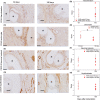Evaluation of the short-term host response and biomechanics of an absorbable poly-4-hydroxybutyrate scaffold in a sheep model following vaginal implantation
- PMID: 34865300
- PMCID: PMC9303173
- DOI: 10.1111/1471-0528.17040
Evaluation of the short-term host response and biomechanics of an absorbable poly-4-hydroxybutyrate scaffold in a sheep model following vaginal implantation
Abstract
Objective: To evaluate the host- and biomechanical response to a fully absorbable poly-4-hydroxybutyrate (P4HB) scaffold in comparison with the response to polypropylene (PP) mesh.
Design: In vivo animal experiment.
Setting: KU Leuven Center for Surgical Technologies.
Population: Fourteen parous female Mule sheep.
Methods: P4HB scaffolds were surgically implanted in the posterior vaginal wall of sheep. The comparative PP mesh data were obtained from an identical study protocol performed previously.
Main outcome measures: Gross necropsy, host response and biomechanical evaluation of explants, and the in vivo P4HB scaffold degradation were evaluated at 60- and 180-days post-implantation. Data are reported as mean ± standard deviation (SD) or standard error of the mean (SEM).
Results: Gross necropsy revealed no implant-related adverse events using P4HB scaffolds. The tensile stiffness of the P4HB explants increased at 180-days (12.498 ± 2.66 N/mm SEM [p =0.019]) as compared to 60-days (4.585 ± 1.57 N/mm) post-implantation, while P4HB degraded gradually. P4HB scaffolds exhibited excellent tissue integration with dense connective tissue and a moderate initial host response. P4HB scaffolds induced a significantly higher M2/M1 ratio (1.70 ± 0.67 SD, score 0-4), as compared to PP mesh(0.99 ± 0.78 SD, score 0-4) at 180-days.
Conclusions: P4HB scaffold facilitated a gradual load transfer to vaginal tissue over time. The fully absorbable P4HB scaffold, in comparison to PP mesh, has a favorable host response with comparable load-bearing capacity. If these results are also observed at longer follow-up in-vivo, a clinical study using P4HB for vaginal POP surgery may be warranted to demonstrate efficacy.
Tweetable abstract: Degradable vaginal P4HB implant might be a solution for treatment of POP.
Keywords: biomechanics; degradable scaffold; host response; pelvic organ prolapse; poly-4-hydroxybutyrate; vaginal surgery.
© 2021 The Authors. BJOG: An International Journal of Obstetrics and Gynaecology published by John Wiley & Sons Ltd.
Conflict of interest statement
CMD, ZG, LH, EV, MZ, EM and JPR declare that they have no competing interests. JD declares that he received a grant from Ethicon (J&J) for an audit of women implanted with Alyte/Ultrapro for abdominal prolapse operations.
Figures








Similar articles
-
Two-Year Preclinical Evaluation of Long-Term Absorbable Poly-4-hydroxybutyrate Scaffold for Surgical Correction of Pelvic Organ Prolapse.Int Urogynecol J. 2024 Mar;35(3):713-722. doi: 10.1007/s00192-023-05720-0. Epub 2024 Mar 2. Int Urogynecol J. 2024. PMID: 38430238 Free PMC article.
-
Evaluation of the histological and biomechanical properties of poly-4-hydroxybutyrate scaffold for pelvic organ prolapse, compared with polypropylene mesh in a rabbit model.Int Urogynecol J. 2022 Aug;33(8):2213-2220. doi: 10.1007/s00192-021-04851-6. Epub 2021 Jun 14. Int Urogynecol J. 2022. PMID: 34125243
-
Evaluation of Electrospun Poly-4-Hydroxybutyrate as Biofunctional and Degradable Scaffold for Pelvic Organ Prolapse in a Vaginal Sheep Model.Macromol Biosci. 2025 Apr;25(4):e2400412. doi: 10.1002/mabi.202400412. Epub 2025 Feb 26. Macromol Biosci. 2025. PMID: 40008865 Free PMC article.
-
Fully resorbable poly-4-hydroxybutyrate (P4HB) mesh for soft tissue repair and reconstruction: A scoping review.Front Surg. 2023 Apr 12;10:1157661. doi: 10.3389/fsurg.2023.1157661. eCollection 2023. Front Surg. 2023. PMID: 37123542 Free PMC article.
-
Update in Transvaginal Grafts: The Role of Lightweight Meshes, Biologics, and Hybrid Grafts in Pelvic Organ Prolapse Surgery.Obstet Gynecol Clin North Am. 2021 Sep;48(3):515-533. doi: 10.1016/j.ogc.2021.05.006. Obstet Gynecol Clin North Am. 2021. PMID: 34416935 Review.
Cited by
-
Advances in vaginal bioengineering: Applications, techniques, and needs.Curr Res Physiol. 2023 Oct 18;6:100111. doi: 10.1016/j.crphys.2023.100111. eCollection 2023. Curr Res Physiol. 2023. PMID: 38107786 Free PMC article. Review. No abstract available.
-
Two-Year Preclinical Evaluation of Long-Term Absorbable Poly-4-hydroxybutyrate Scaffold for Surgical Correction of Pelvic Organ Prolapse.Int Urogynecol J. 2024 Mar;35(3):713-722. doi: 10.1007/s00192-023-05720-0. Epub 2024 Mar 2. Int Urogynecol J. 2024. PMID: 38430238 Free PMC article.
-
The Regenerative Capacity of Tissue-Engineered Amniotic Membranes.ACS Appl Bio Mater. 2024 Mar 18;7(3):1441-1448. doi: 10.1021/acsabm.3c00765. Epub 2024 Feb 23. ACS Appl Bio Mater. 2024. PMID: 38391263 Free PMC article.
-
Absorbable Electrospun Poly-4-hydroxybutyrate Scaffolds as a Potential Solution for Pelvic Organ Prolapse Surgery.ACS Appl Bio Mater. 2022 Nov 21;5(11):5270-5280. doi: 10.1021/acsabm.2c00691. Epub 2022 Oct 31. ACS Appl Bio Mater. 2022. PMID: 36315937 Free PMC article.
-
Validation of an ovine vesicovaginal fistula model.Int Urogynecol J. 2022 Nov;33(11):3185-3193. doi: 10.1007/s00192-022-05342-y. Epub 2022 Sep 19. Int Urogynecol J. 2022. PMID: 36121458 Free PMC article.
References
-
- Lakeman MM, van der Vaart CH, Laan E, Roovers JPW. The effect of prolapse surgery on vaginal sensibility. J Sex Med. 2011;8(4):1239–45. - PubMed
-
- Weber MA, Lakeman MM, Laan E, Roovers JPW. The effects of vaginal prolapse surgery using synthetic mesh on vaginal wall sensibility, vaginal vasocongestion, and sexual function: a prospective single‐center study. J Sex Med. 2014;11(7):1848–55. - PubMed
-
- Hympanova L, Rynkevic R, Roman S, Mori da Cunha M, Mazza E, Zundel M, et al. Assessment of electrospun and ultra‐lightweight polypropylene meshes in the sheep model for vaginal surgery. Eur Urol Focus. 2020;6(1):190–8. - PubMed
-
- Birch C, Fynes MM. The role of synthetic and biological prostheses in reconstructive pelvic floor surgery. Curr Opin Obstet Gynecol. 2002;14(5):527–35. - PubMed
MeSH terms
Substances
Grants and funding
LinkOut - more resources
Full Text Sources
Miscellaneous

